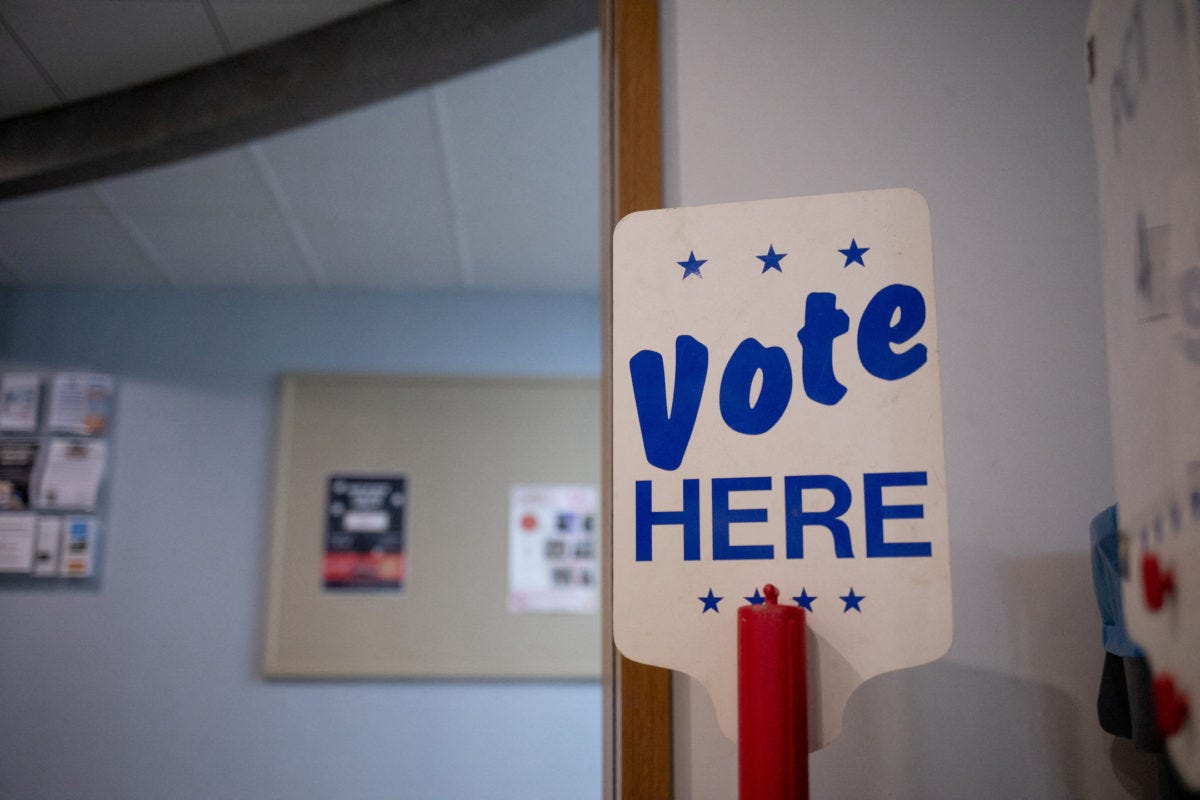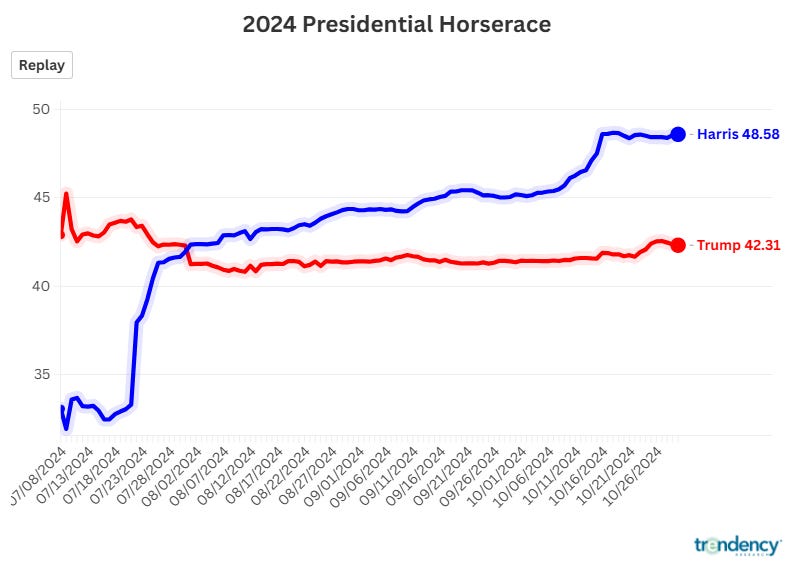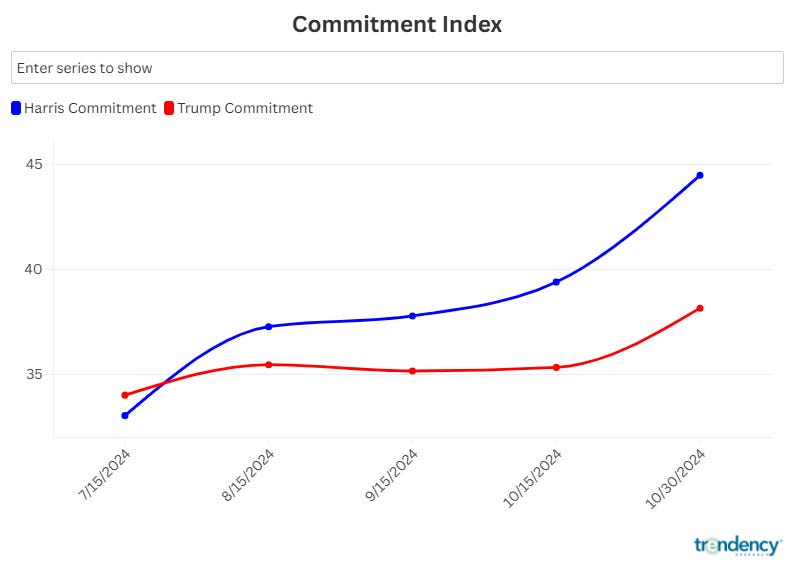a Trendency feature
Tomorrow marks the last day of voting in the 2024 general election. While we are feeling very certain that it will be many days after November 5th before we have an announced winner in the Presidential election (and potentially control of both Congress and the Senate), the likely outcomes are still murky. What feels most likely to us is that Vice President Kamala Harris will win the popular vote by a comfortable margin. What is less certain is who will win the Electoral College. Every outcome, from Harris or former President Donald Trump winning resoundingly to a too-close-to-call result in the Electoral College, is in the realm of likely.
To close out this election, the team at Trendency has updated the graphs we discussed on our October 17th webinar (if you missed it, there is a recording here). An interactive version of these graphs is posted on our website here (click here).
The National Horserace
Since late July, the Trendency numbers have shown Harris with an advantage on the average allocation question. As a reminder, we do not ask questions in a binary fashion (e.g. are you voting for Harris or Trump?). Instead, we ask about the chances of voting for each candidate, allowing our panelists to give more nuance to their answers and allowing us to understand how opinions are shifting, even if the shift is not from one choice to another. This is not an exact apples-to-apples comparison with what you will see reported from snapshot surveys, but it provides a more comprehensive look at how people are feeling about their choices, as well as their likely future behavior.
Across our national panels, Harris’ average allocation has been, for the most part, on the rise since she became the presumptive Democratic nominee back in late July. More recently, her support grew steadily through the beginning of October and has been increasing at a much slower pace over the past few weeks. During the past three months, Trump’s support has been more steady, with a slight increase in his average support over the past two weeks as we get closer to Election Day.
While traditional methods of research have pointed to a stagnant homestretch, our look at the data paints a very different picture. Both candidates have seen shifts in their support level among key demographic groups. Since October 15th, Harris has increased her level of support among most cohorts; her biggest increases have been among Black men, White women, and voters under the age of 40. She also has seen notable gains among White men. The only group where her support shrank during this period was among Latina voters.
During the same time period, Trump’s change in support has been a little bit more of a mixed bag. His biggest growth has been among Latino and Latina voters, while his biggest drop has been among Black men. Support among White women dropped slightly while White men increased by about a point. When it comes to age, Trump’s support grew by about 2 points on average among voters under 40, but dropped slightly among all other age groups.
Comparing the support for the two candidates, the biggest delta is among Black women followed by Black men. Older voters, as well as White women, currently have a near double-digit difference. Harris has a higher allocation among most of these groups, with the exceptions being among White men (where Trump has about a one-point advantage) and Latino voters (where his advantage is roughly seven points, on average).
When dealing with averages, the overall results can oftentimes mask what is really happening in the data. In the case of partisan politics, an average of 50 does not mean everyone is equally allocating between the two choices (aka completely undecided); indeed, most are strongly supporting one candidate while also being strongly opposed to the idea of supporting the other. As we can see in the chart below, almost all voters are at the bookends with very few in the middle reporting that they are unsure of their vote.
For Harris, currently, 45 percent of voters are allocating 80 percent or higher on their likelihood to support her candidacy, while 47 percent state that there is very little to no chance that they will support her (under 20 percent chance). For Trump, his strong support is currently at 38 percent, with 54 percent of voters saying that they are unlikely to support his candidacy.
Looking at these distributions, there are several clear takeaways …
First, Harris has an advantage when it comes to both the strong supporters and having a lower concentration of strong detractors.
Second, both candidates have a higher negative concentration than the positive, meaning there is more motivation to vote against a candidate than there is voting for a candidate.
Third, even though both candidates are underwater in terms of the positive versus negative motivations, only one candidate has a majority of voters ruling out voting for them nationally: Trump.
Fourth, and finally, there are very few voters in the middle who are leaning, but not sold on either candidate (roughly 8 percent).
Looking at the last two weeks, the Harris campaign has done a good job of solidifying her support. Her strong support increased from 39 percent on October 15th to 44.5 percent on the 30th. At the same time, the concentration of voters who are opposed to the idea of supporting her candidacy barely moved (down 0.3 percentage points).
During this same time period, Trump also increased his concentration of strong supporters. On October 15th, 35 percent of voters said there was an 80 percent chance or higher that they would be voting for the former President. Two weeks later, that number increased to 38.2 percent, an increase of 3.2 percentage points. At the same time, his negative numbers increased by 1.5 percentage points (going from 52 percent to 53.5%).
Looking at the strong supporters, what we refer to as the Commitment Index, both campaigns have done a good job of solidifying their support over the last two weeks. Since mid-August, the Harris campaign has done a remarkable job of increasing the concentration of voters in the committed range. In August, 37.3 percent of voters were at this level, and currently the number stands at 44.5 percent. This 7.2-point increase represents a 19% increase over the past two and a half months. For the Trump campaign, his committed voters increased from 35.5 percent in mid-August to 38.2 percent at the end of October, resulting in a 2.7 point increase or 7.6 percent increase over the last 75 days.
On the opposite side of the spectrum, we see a difference in the two candidates over the past two and a half months. There are two main motivators in a decision: you can either support your choice, or you can reject the idea of the choice you are not making. This double negative is not making many English teachers happy - but it is basically the idea of voting for a candidate versus voting against the other candidate. The motivation for voting against a candidate is what we refer to as the Rejection Index.
A candidate would ideally have this number as low as possible. In mid-July, before Harris became the nominee, and while President Biden was still running for re-election, roughly 55 percent of voters rejected the idea of supporting Harris and Trump. After becoming the nominee, Harris’ Rejection Index dropped to 50 percent, while Trump’s dropped to 52.9 percent. Since that point, Harris’ Rejection Index has dropped slowly, but steadily, ending at 47.3 percent. Trump’s, on the other hand, remained steady through mid-October but has seen an increase over the last two weeks, ending at 53.7 percent.
If we combine these two measurements and subtract the Rejection from the Commitment, we can understand where the motivation is mainly coming from for voters. In an ideal world, a candidate would like to see the difference in positive territory.
With the election coming to a head next week, neither candidate has moved into positive territory in this measurement. Between the increase in strong support and the decrease in the rejection of her candidacy, Harris has seen a slow, but steady rise in the difference between those strongly supporting her and those strongly opposed. She currently stands at -2.84 an increase of 5.52 points over the past two weeks and 7.81 since September 15th. During this same time period, Trump’s number increased by 1.54 points over the past two weeks and 1.57 over the past 45 days.
To read more about how 2020 Voters are voting in this year's election and data from a few swing states you can read the rest of the post here.













